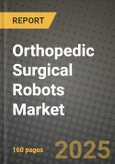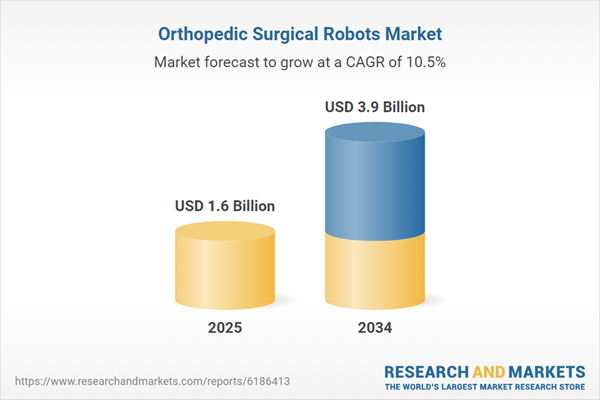The orthopedic surgical robots market has been expanding rapidly, driven by advancements in robotic-assisted surgery, increasing demand for precision-based procedures, and the growing adoption of minimally invasive orthopedic surgeries. Orthopedic surgical robots enhance surgical accuracy, improve patient outcomes, and reduce post-operative complications by offering real-time imaging, AI-guided navigation, and robotic-assisted precision in bone cutting and implant placement. These systems are widely used in joint replacement surgeries, spinal procedures, and trauma fixation, providing surgeons with greater control and reducing the margin for human error. The rising prevalence of osteoarthritis, osteoporosis, and musculoskeletal disorders, coupled with an aging population, has fueled demand for robotic-assisted orthopedic procedures. Additionally, increasing healthcare investments, technological innovations, and favorable reimbursement policies in key markets have accelerated adoption. Despite the high initial costs and training requirements for robotic systems, ongoing research and development (R&D) in AI-driven automation and next-generation robotic platforms continue to drive market growth.
The orthopedic surgical robots market witnessed notable advancements in AI-powered automation, real-time analytics, and robotic-assisted surgical systems. The adoption of AI-integrated robotic platforms allowed surgeons to achieve greater precision in joint replacements and spinal fusion surgeries, reducing surgical errors and improving patient recovery times. The demand for robotic-assisted knee and hip replacement surgeries surged, particularly in North America and Europe, as hospitals and surgical centers invested in next-generation robotic platforms to enhance procedural accuracy. Innovations in haptic feedback technology improved surgeon control, minimizing the risk of soft tissue damage during orthopedic procedures. Additionally, the integration of augmented reality (AR) and real-time 3D imaging into robotic-assisted surgeries enhanced visualization and preoperative planning. Market leaders expanded their portfolios by launching next-generation robotic platforms with AI-driven decision-making capabilities, improving operational efficiency. However, cost-related challenges and the need for extensive surgeon training continued to limit adoption in smaller hospitals and emerging markets. Despite these barriers, the market experienced strong growth, driven by increasing patient demand for minimally invasive procedures and hospital investments in surgical automation.
The orthopedic surgical robots market is expected to experience further expansion, fueled by AI-driven predictive analytics, remote surgical capabilities, and advancements in robotic hardware. The integration of machine learning and big data analytics will enable personalized surgical planning, allowing for optimized implant positioning and faster recovery times. Remote robotic-assisted surgeries will gain traction, particularly in regions with limited access to highly skilled orthopedic surgeons, bridging healthcare accessibility gaps. Emerging markets in Asia-Pacific and Latin America will play a critical role in market expansion as government healthcare initiatives promote robotic-assisted surgeries to improve surgical outcomes. The development of compact, cost-effective robotic surgical systems will enhance adoption in smaller hospitals and ambulatory surgical centers, increasing market penetration. However, challenges related to regulatory approvals, reimbursement complexities, and high equipment costs will continue to impact widespread adoption. Despite these hurdles, the orthopedic surgical robots industry is poised for substantial growth, driven by continuous technological innovations, increasing demand for precision-based orthopedic surgeries, and expanding global healthcare infrastructure.
Key Insights: Orthopedic Surgical Robots Market
- AI-Driven Automation in Robotic Orthopedic Surgeries: The integration of artificial intelligence in robotic surgical systems is enhancing decision-making, precision, and automation in orthopedic procedures, reducing surgical errors and improving patient outcomes.
- Expansion of Augmented Reality and 3D Imaging in Surgical Planning: The adoption of AR and 3D imaging technologies is improving preoperative planning and intraoperative visualization, enabling more precise implant positioning and joint alignment.
- Development of Cost-Effective and Compact Robotic Systems: Emerging manufacturers are focusing on developing smaller, affordable robotic platforms to increase accessibility in outpatient surgical centers and smaller hospitals.
- Rise in Remote and Tele-Robotic Surgeries: The advancement of robotic-assisted remote surgeries is enabling specialists to perform orthopedic procedures in remote locations, addressing healthcare access challenges.
- Growing Use of Haptic Feedback Technology for Enhanced Surgeon Control: Innovations in haptic feedback technology are improving robotic system responsiveness, allowing surgeons to maintain better control during bone cutting and implant placement.
- Increasing Demand for Minimally Invasive Orthopedic Surgeries: Patients and surgeons are favoring robotic-assisted minimally invasive procedures due to reduced recovery times, lower surgical risks, and improved outcomes.
- Rising Prevalence of Osteoarthritis and Musculoskeletal Disorders: The growing incidence of joint degeneration, fractures, and spinal conditions is driving demand for precision-based orthopedic surgical robots.
- Advancements in AI, Machine Learning, and Robotics Technology: Continuous innovations in AI-driven surgical planning, robotic hardware, and sensor-based navigation systems are enhancing the effectiveness of orthopedic robotic procedures.
- Expansion of Healthcare Infrastructure in Emerging Markets: Government healthcare investments in robotic-assisted surgery and hospital automation are increasing the adoption of orthopedic surgical robots in developing regions.
- High Costs and Regulatory Barriers for Robotic Surgical Systems: The expensive nature of orthopedic surgical robots, coupled with complex regulatory approval processes, poses challenges for widespread adoption, particularly in cost-sensitive markets.
Key Trends, market drivers, and challenges shaping its future. Would you like insights into specific robotic systems, regional market trends, or competitive strategies?
Orthopedic Surgical Robots Market Segmentation
By Product
- Robotic System
- Robotic Accessories
- Software and Services
By Application
- Partial Knee Replacement
- Total Knee Replacement
- Minimally Invasive Surgery (MIS) Fusion
- Other Applications
By End-User
- Ambulatory Surgical Centers
- Hospitals
- Specialty Clinics
- Other End-Users
Key Companies Analysed
- Johnson & Johnson
- Medtronic plc
- Siemens Healthineers
- Stryker Corporation
- Zimmer Biomet Holdings Inc.
- Intuitive Surgical Inc.
- Smith & Nephew plc
- Globus Medical Inc.
- MicroPort Orthopedics Inc.
- Renishaw plc
- Medacta International
- Aesculap Inc.
- Accuray Incorporated
- Brainlab
- Exactech Inc.
- Corin Group
- THINK Surgical Inc.
- TINAVI Medical Technologies Co Ltd.
- CUREXO Inc.
- OrthAlign Inc.
- 4WEB Medical
- OMNI Orthopaedics Inc.
- Monogram Technologies Inc.
- Asensus Surgical Inc.
- Medicaroid Corporation
Orthopedic Surgical Robots Market Analytics
The report employs rigorous tools, including Porter’s Five Forces, value chain mapping, and scenario-based modeling, to assess supply-demand dynamics. Cross-sector influences from parent, derived, and substitute markets are evaluated to identify risks and opportunities. Trade and pricing analytics provide an up-to-date view of international flows, including leading exporters, importers, and regional price trends.Macroeconomic indicators, policy frameworks such as carbon pricing and energy security strategies, and evolving consumer behavior are considered in forecasting scenarios. Recent deal flows, partnerships, and technology innovations are incorporated to assess their impact on future market performance.
Orthopedic Surgical Robots Market Competitive Intelligence
The competitive landscape is mapped through proprietary frameworks, profiling leading companies with details on business models, product portfolios, financial performance, and strategic initiatives. Key developments such as mergers & acquisitions, technology collaborations, investment inflows, and regional expansions are analyzed for their competitive impact. The report also identifies emerging players and innovative startups contributing to market disruption.Regional insights highlight the most promising investment destinations, regulatory landscapes, and evolving partnerships across energy and industrial corridors.
Countries Covered
- North America - Orthopedic Surgical Robots market data and outlook to 2034
- United States
- Canada
- Mexico
- Europe - Orthopedic Surgical Robots market data and outlook to 2034
- Germany
- United Kingdom
- France
- Italy
- Spain
- BeNeLux
- Russia
- Sweden
- Asia-Pacific - Orthopedic Surgical Robots market data and outlook to 2034
- China
- Japan
- India
- South Korea
- Australia
- Indonesia
- Malaysia
- Vietnam
- Middle East and Africa - Orthopedic Surgical Robots market data and outlook to 2034
- Saudi Arabia
- South Africa
- Iran
- UAE
- Egypt
- South and Central America - Orthopedic Surgical Robots market data and outlook to 2034
- Brazil
- Argentina
- Chile
- Peru
Research Methodology
This study combines primary inputs from industry experts across the Orthopedic Surgical Robots value chain with secondary data from associations, government publications, trade databases, and company disclosures. Proprietary modeling techniques, including data triangulation, statistical correlation, and scenario planning, are applied to deliver reliable market sizing and forecasting.Key Questions Addressed
- What is the current and forecast market size of the Orthopedic Surgical Robots industry at global, regional, and country levels?
- Which types, applications, and technologies present the highest growth potential?
- How are supply chains adapting to geopolitical and economic shocks?
- What role do policy frameworks, trade flows, and sustainability targets play in shaping demand?
- Who are the leading players, and how are their strategies evolving in the face of global uncertainty?
- Which regional “hotspots” and customer segments will outpace the market, and what go-to-market and partnership models best support entry and expansion?
- Where are the most investable opportunities - across technology roadmaps, sustainability-linked innovation, and M&A - and what is the best segment to invest over the next 3-5 years?
Your Key Takeaways from the Orthopedic Surgical Robots Market Report
- Global Orthopedic Surgical Robots market size and growth projections (CAGR), 2024-2034
- Impact of Russia-Ukraine, Israel-Palestine, and Hamas conflicts on Orthopedic Surgical Robots trade, costs, and supply chains
- Orthopedic Surgical Robots market size, share, and outlook across 5 regions and 27 countries, 2023-2034
- Orthopedic Surgical Robots market size, CAGR, and market share of key products, applications, and end-user verticals, 2023-2034
- Short- and long-term Orthopedic Surgical Robots market trends, drivers, restraints, and opportunities
- Porter’s Five Forces analysis, technological developments, and Orthopedic Surgical Robots supply chain analysis
- Orthopedic Surgical Robots trade analysis, Orthopedic Surgical Robots market price analysis, and Orthopedic Surgical Robots supply/demand dynamics
- Profiles of 5 leading companies - overview, key strategies, financials, and products
- Latest Orthopedic Surgical Robots market news and developments
Additional Support
With the purchase of this report, you will receive:- An updated PDF report and an MS Excel data workbook containing all market tables and figures for easy analysis.
- 7-day post-sale analyst support for clarifications and in-scope supplementary data, ensuring the deliverable aligns precisely with your requirements.
- Complimentary report update to incorporate the latest available data and the impact of recent market developments.
This product will be delivered within 1-3 business days.
Table of Contents
Companies Mentioned
- Johnson & Johnson
- Medtronic PLC
- Siemens Healthineers
- Stryker Corporation
- Zimmer Biomet Holdings Inc.
- Intuitive Surgical Inc.
- Smith & Nephew PLC
- Globus Medical Inc.
- MicroPort Orthopedics Inc.
- Renishaw PLC
- Medacta International
- Aesculap Inc.
- Accuray Incorporated
- Brainlab
- Exactech Inc.
- Corin Group
- THINK Surgical Inc.
- TINAVI Medical Technologies Co Ltd.
- CUREXO Inc.
- OrthAlign Inc.
- 4WEB Medical
- OMNI Orthopaedics Inc.
- Monogram Technologies Inc.
- Asensus Surgical Inc.
- Medicaroid Corporation
Table Information
| Report Attribute | Details |
|---|---|
| No. of Pages | 160 |
| Published | October 2025 |
| Forecast Period | 2025 - 2034 |
| Estimated Market Value ( USD | $ 1.6 Billion |
| Forecasted Market Value ( USD | $ 3.9 Billion |
| Compound Annual Growth Rate | 10.4% |
| Regions Covered | Global |
| No. of Companies Mentioned | 25 |









